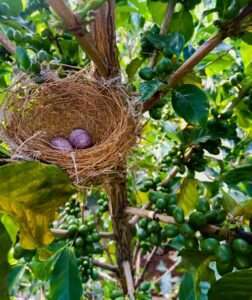 Spring and summer may bring birds to nest in your garden, even if you don’t set up nest boxes to attract them. Certain birds, including the house finch, seem to even prefer garden objects and home architecture over more natural nest sites. Here are questions (and answers) that often come up when birds are nesting near people:
Spring and summer may bring birds to nest in your garden, even if you don’t set up nest boxes to attract them. Certain birds, including the house finch, seem to even prefer garden objects and home architecture over more natural nest sites. Here are questions (and answers) that often come up when birds are nesting near people:
There’s a bird’s nest in my hanging plant. What should I do?
It’s best for the birds if you wait out the nesting period rather than attempt to move the nest. In fact, under the Migratory Bird Treaty Act, it is illegal to move a bird’s nest because it’s an inconvenience. (For more about this Act and its implications, see this post from Cornell University’s NestWatch.) You can gently, lightly water the plant, directing the water into the potting soil at a point away from the nest. Once the young birds have permanently left the nest, remove it and keep watch for future nesting attempts. House finches, in particular, raise two broods per season and may try to reuse an abandoned nest or build a new one in your plant. Remove materials as they appear and the birds will become discouraged and move elsewhere.
I’ve found a baby bird on the ground. What should I do?
First try to determine how old the bird is. If it is fully feathered yet immature looking, and clumsy but mobile, it’s likely a fledgling that is ready to leave the nest. Its parents are still caring for it and you can leave it be, or at most move it out of immediate danger (such as off of a sidewalk and into some shrubbery). If the bird has down instead of feathers, or if its wing feathers look like tubes, it is a hatchling or nestling and not ready to be out of the nest. In this case you should try to find the nest and place the bird back into it. (The parents will continue to care for it once you do.) For more information, see this post from Mass Audubon.
MEGHAN SHINN www.hortmag.com




